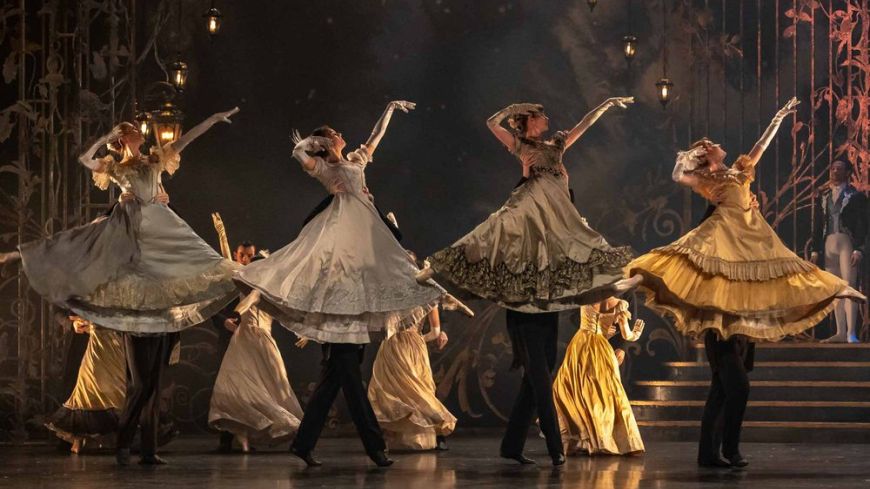
This sparkling new version of Cinderella has been given a fashionable, gender-fluid update, in which Cinders will be played by either a male or female dancer, partnered by Princess Louise or Prince Louis. It brings a refreshing rather than a radical change, as it’s nearly 30 years ago since Matthew Bourne’s legendary ‘Swan Lake’ featured a corps de ballet of bare-chested, fiercely macho, masculine swans. From the Shakespearian era to Sarah Bernhardt as Hamlet in Paris (1899), role reversal has long been part of the theatrical stage.
It’s the turn of the 20th century and the façade of a classy couture Boutique is illuminated with shadowy silhouettes before the doors open to take us inside Rose’s Milliners and Drapery. It’s all hustle and bustle with rolls of material, colourful threads, dressmaker’s dummy, hats galore; At this particular show, a young boy sits patiently on the counter while his parents are working, then jumps down to race about and play with his father, twirling around in a jolly polka.
Tragically, Mr and Mrs Rose soon die in a fire at the shop, while the child rises from the ashes, nicknamed Cinders and unwittingly ‘adopted’ by the new owner, Mrs Thorne. With a suitably sharp, prickly manner, she arrives with her three spoilt children; amusingly dressed in garish stripes, feathered hats, fake fur, checked tweed, they try, but fail, to capture an aristocratic look.
The classic romantic story now takes over as the Thorne family are madly excited about attending the Royal Ball: with slick, slapstick timing, the three badly behaved children Morag, Flossie and Tarquin fool around like a trio of clowns in their gleeful effort to snatch Cinders’ invitation. But, of course, there’s a sprinkle of fairytale magic amidst a haunting vision from the past in the Rose Garden.
The set designs (and seamless, speedy scene changing) are simply mesmerising with an array of elaborate backdrops, newspaper headlines, giant clock, flowers and huge velvet drapes floating across the stage. Ornate wrought iron gates guard the Royal Palace where inside, the lavish ballroom is framed by leaf-sculptured trellis screens, art nouveau lamps and grand sweeping staircase.
The guests are gathered for the Ball hosted by Princess Louise – in sparkling royal blue and white organza – and the charismatic and rather camp, Duke of Orleans and Duke of Tonnerre. Graceful couples waltz their way in ever increasing circles, the ladies parading their shimmering lace-trimmed gowns in shades of gold, bronze and cream, the men, suitably suave in black tie and tails. The synchronicity of extended arms and legs in arabesque line formation is exquisitely performed, as well as high leaps with acrobatic agility. Christopher Hampson’s choreography complements each en pointe step and bar of the dramatic Prokofiev score with precise rhythm and dramatic pace.
Meanwhile, in outrageous pink, red and yellow costumes, the three ‘clowns’ take to the floor to show off their dance moves with hilarious, pantomimic disaster – it takes superlative comedic skill to take a clumsy trip and tumble while perfecting a pirouette with a handsome Duke.
The surprise arrival of Cinders, in a gorgeous navy blue and gold embroidered jacket, quickly catches the eye of Princess Louise, who makes the first move inviting him to dance while he kneels in deference to her regal status. Their enchanting series of pas de deux develops slowly and surely, leading to a close embrace .... just as the clock strikes midnight. (With four different couples cast as the changeable double act, just a few tentative moves and lifts by Evan Loudon and Marge Hendrick, although this was the first night in Edinburgh).
Hampson’s modernised narrative creatively removes the dusty old stereotypical characters – no Fairy Godmother, cruel stepmother or bullying stepsisters, and Cinders is no longer a shy, vulnerable servant in the kitchen but cool, confident and determined to succeed. A clever twist in the end leads the happy couple back to the Rose Emporium rather than to life at the Royal Palace.
With the cultural shake up of gender roles, glamorous dance sequences and pantomimic fun and games, the storyline is crystal clear through the lyrical language of choreography - a Festive, romcom, theatrical entertainment for all ages.
Showtimes:
Festival Theatre, Edinburgh, 5 – 20 January, 2024
His Majesty’s theatre, Aberdeen, 24 – 28 January, 2024,
Eden Court, Inverness, 31 January, – 3 February, 2024
Theatre Royal, Newcastle, 7 – 10 February, 2024
www.scottishballet.co.uk/cinders

